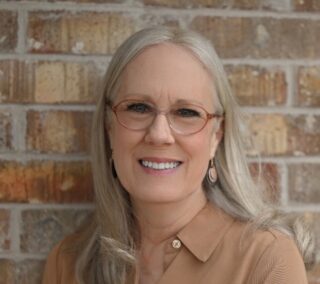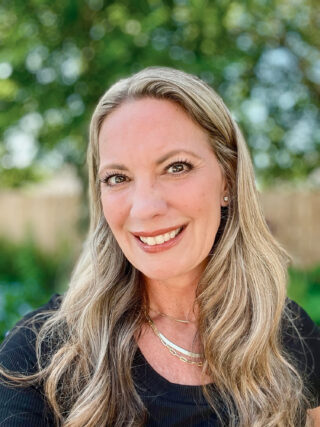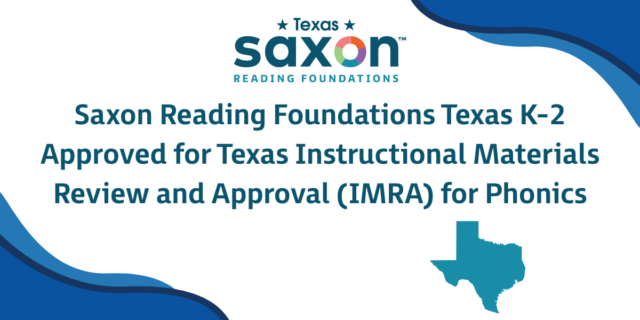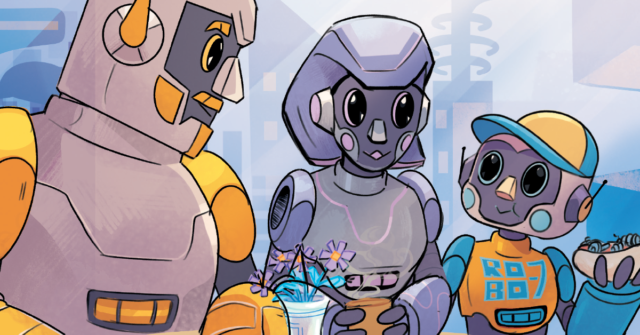
How can we make phonics instruction work for every child regardless of ability or background?
Today's guest, Lorna Simmons, has spent decades pursuing the answer to that question. Her journey, rooted in a deep commitment to literacy for all, has culminated in the release of Saxon Reading Foundations, which launched in June. This new program reflects years of research, classroom experience, and a relentless drive to ensure every student can become a confident reader. Lorna has developed tools and techniques that help educators meet students where they are, whether they need 15 exposures or 1500.
In this episode, she explores how we can bridge the gap between phonics instruction and authentic reading success. Lorna shares practical ways to embed phonics into every subject, use controlled texts effectively, and ensure students get the exposures they need to truly master decoding. Whether you're teaching kindergarten or upper elementary, this conversation will help you unlock the power of phonics across your entire day.
Lorna is in conversation with Amy Mengarelli, one of our partners with the Waymire Group and a former classroom teacher.
Transcript
Amy Mengarelli:
Recently, I was meeting with a friend of mine who's in the classroom, this is her 27th year. And one of the things that she brought up to me was even in year 27, we are so crunched for time in our day, we have so many things we have to do, and we know when we're working with phonics instruction and those foundational literacy skills, it's so important that we get that in along with everything else that we're doing. How do we fit it all in?
Lorna Simmons:
There's a lot to fit in, and I realize that, and it's really important for teachers to realize that students nowadays are not used to sitting down for long periods of time to learn something because they're used to being on Instagram and different things that they're doing that is very short and quick.
And so I've been trying to tell teachers to try to break their lessons up a lot more than they have been. I always start with the review decks and do the new learning, but as soon as they go to the workbook page to start breaking into different groups and have workstations for them, so that each child can be met in a separate time block than just that one big one that opens the lesson.
Amy:
So I hear you're saying that we have different opportunities within our lessons to be able to kind of break things up. I remember one of the things that I'm also seeing as I'm meeting with teachers and administrators is they're trying to find ways to thread content into our literacy blocks.
And I know you have spent so many years in the world of phonics and research and those foundational skills. With phonics following such a tight kind of scope and sequence, how can we thread content literacy in through maybe our phonics block and kind of remove those silos that sometimes happen when we're in the classroom and we're so focused on our different time chunks in the general day? How could we possibly do that?
Lorna:
Well, I like a very controlled text, and so I like for the students to be learning what they had previously been taught. But because we go into other subjects, social studies, science, math, there's going to be words in there that they can't read easily that are actually on the worksheet that they need to be able to read.
So I always tell teachers, try to bring those words in, and even if you're teaching something ahead, that's okay. You can teach that. Code the words. Show them that phonics works across all levels of education. Every single subject is going to have phonics within the reading.
And so I have teachers code different words, and if you've covered something, say you brought up IGH and they've never had it before, go ahead and teach it at that moment. You're going to have it show up later in programs where you can actually code it, but at least they can have that review process knowing that they need that word right now. And so anytime that they're doing it, they should be able to bring any subject into their phonics schedule time and work with that and them learn something a little bit ahead of time.
Amy:
Just kind of thinking about that, I really do love that concept because I kind of grew up in the siloed era of education, and what we did in phonics, that's what we did in phonics. And the fact that I'm hearing you say bring in some of that content vocabulary during your phonics instruction and that it's okay if you haven't taught those concepts yet. Teach them right now. Go ahead and give them those tools that they need to be able to be successful when we hit that content vocabulary in our science, math, or social studies texts.
So do you think that that will also kind of help with the transfer of skills? That's one of the conversations that I often have, and I'm wondering if you see the same thing. When we are teaching phonics in that dedicated time, sometimes it seems like there's not necessarily that same transfer of skills over to the other areas. What are you seeing, and do you think that's something that can help with that?
Lorna:
Yeah. I always tell teachers that the transfer won't take place, first of all, if they don't understand that this goes across all modes of whatever they're learning about, but the kids need to know that when they see a word, there is something they can decode in it.
Many times, it's something they haven't had before, and that's why you didn't see the transfer. But if they'll go ahead and bring it in, go, "Oh my goodness, we haven't had this before," we can learn it now, and I'll go ahead and let you be an understanding.
Another thing that I'd like to see with kids is when they're walking down the halls or doing different things like that, they can be reviewing some of the information, and it helps if the teacher feels comfortable to bring phonics in all through the day. May know when they're outside doing different things, where they see that, "Oh, look at the sign over here. It's got a word written on it." Anything to make those kids understand that this is a world all around them, and it works in every situation.
Amy:
Okay. I'm so glad you just said that. It was almost like you were peeking into my life as a teacher because I remember that we would get the call from the main office, okay, the cafeteria line is running 10, 15 minutes behind. What in the world am I going to do with my kiddos during that time as we're standing in line waiting for the cafeteria line to go down? Because sometimes, I had just little flashcards, or I would just make up my own cards to just do quick little reviews. You have some review decks, don't you?
Lorna:
Yes. And the review decks, I should mention, are very important within a classroom because if you have any children that are having problems, it's critical that you review what they've learned in the past. Otherwise, there's a chance if you taught it today, they do not have mastery on the day you teach something. In fact, if you have children that are dyslexic, it might take up to 1500 exposures.
Amy:
Wow.
Lorna:
And if you don't mind, can I show you a little bit about what we do on a review deck and what I-
Amy:
Yeah, yeah.
Lorna:
... teach with Saxon?
Amy:
I would love to see that because I know what I had created by hand, but I would love to see yours because I love the idea of that constant repetition and review.
Lorna:
I always review all of these things. I'm going to show you very quickly. I always review the letters that they've learned, and this is an easy deck. They would just say, "B", then they would say, "V," and then they would have the picture that goes with each one of those. And then after that, we would talk about the affixes, suffixes, this is something they've already covered in the past, and then they would go over any of the sight words that they've had in the past.
Now, it's important to review those, and it's important to understand that children that have learning difficulties a lot of times need to separate the letter and the letter sound, because the picture is not going to be in words, and so that's why we have them separate. The goal at some point is to pull away from the picture and have that something that they remember so they can get back to their sound just with the letter itself.
You're trying to work around some of the problems that children have, and reviewing everything they've learned from the past is really important. As they go forward, we go to the harder deck. This would be more like what they're learning in class today.
But the children that are having trouble, while they're doing their worksheet, I would have the children having more trouble that are struggling, come back with you as a teacher and go over all of the older things that they've learned since day one because they may not have mastered that yet. And mastery is something we're trying to go for, but sometimes it takes a lot longer than teachers realize for students to get it.
Amy:
And I am so glad you just pointed that out, because going back to what we first were talking about, we have so many things to cover, sometimes, it feels like as we're moving through curriculum, it's a one-and-done when we get into teaching our lessons. And you're right. It cannot be a one-and-done.
Especially how many touch points did you say our students with dyslexia might need to have for mastery? Was it-
Lorna:
About 1500 for some.
Amy:
1500?
Lorna:
I think my son is right there.
Amy:
Amazing. Amazing. I mean, and that's something that I think as we get wrapped up in our daily grind of making sure we're fitting everything in, it's so important to make sure that we are also going back and constantly spiraling and reviewing and giving that application.
And of course, my mind just also went back to, "Oh, content. We're going to see some of those letters, some of those words. I could pull in some of that content, academic vocabulary as well, and relate it back to maybe something we were doing in the other content areas." I love all the connections that you're able to make with these different review points.
And so thinking about that and thinking about what you just said about making sure that the students have as much exposure as possible, I know with small group instruction, that's where we can really hone in on those skills. But when we're looking at that, how do we know who to pull, how to pull? I mean, there's so many different thoughts in the world of small group instruction. But what is your suggestion when we need to start pulling small groups for our foundational skills and phonics instruction?
Lorna:
Well, I personally love small groups because I like to have each one of them really working at something that's hard for them a little bit. A bit of a challenge so that not everything is super easy for our high achievers, but I also want the ones that are struggling to be able to have success.
Now, I'm going to go back to something you said earlier. We talk about exposures. The only way we're going to get enough exposures is if we have those small groups to bring those children back, because an exposure doesn't count if you're doing something as a whole group and all the students are answering it because the struggling student usually is that little bit behind and listening to the other ones for answers, so they're not actually resurfacing that information from their own brain.
And so small groups are very important to make sure those kids actually have to bring up that information themselves, even if it's something as simple as just, "What is this letter?" Well, the other kids say B, they're right behind them, just that slight second behind them giving the answers, and so the small group really helps with that.
Now, as you're doing the worksheets, you really have an idea who to pull and who not to pull, because if you have children that can go through the whole worksheet, read it completely easily, then obviously you don't need to help them with that. You might correct a few things, but other than that, they don't need to have any kind of guided practice with that.
But if you have other students that are just really not understanding what they're doing, then you need to be able to pull those students back and maybe guide them through it. You may not even be able to do the entire worksheet. You might actually have them just do some of the words that you feel are most beneficial and read some. But making sure that every child has the opportunity to read some of the information or read some of the paper themself, especially some of the text, because we want them to be reading in text as often as possible.
Amy:
So Lorna, when we're looking at our students as they're doing some of that independent work, you're right. That is a great place where we can kind of assess on demand. I know sometimes we think about assessment as it has to be this formalized test at the end of a unit or at the end of the week or at the end of a lesson.
But really, as we're walking around, we can use that as an informal assessment to then see who do we need to pull over to the side that needs that help? And we can quickly see, "Okay, yes. Everybody in this group is struggling with the same concept, then."
So when we're doing that and we're working with our students in those small groups, what about the other students? I heard you mention some of our students that they don't need any help. They're acing it, or they might just need one or two little small corrections. What are our other students doing when I am pulling those small groups to really hone in and refine the skills that they need help with? What is everybody else doing?
Lorna:
Well, I had workstations last year when I was teaching, and there was all different levels of workstations, and within a workstation, there was also a level within that.
Amy:
Oh, wow.
Lorna:
And so they might be doing kid cards. Some children might have the pictures down and just have one word coming up where they have to find the picture of that one word they're holding, but then the next group, they might know that they have to put the words down and just hold the picture up. Therefore, they had to read possibly all the words to find their one picture, so they were leveled in that way.
Also, we have readers that, I mean, I hope that every teacher has readers in different levels so they can have the students work with readers that are appropriate for what they're doing. If you don't, can I show you a couple of readers just to give you an idea of what I'm talking about?
Amy:
Yeah, yeah. Please do.
Lorna:
I think it helps teachers understand, because even if you don't use our program, you can maybe look for the same situation. This be level-three reader, and-
Amy:
Now, before we go on, so levels, and everybody has their own sense of levels. So when we're talking about levels, and you're saying a level three, are you talking about harder, easier, on level? What are we talking about with level three here?
Lorna:
Yeah. With level three in this particular program, it's going to be by the lesson. They need to not teach this one until lesson 25.
Amy:
Okay. So it's going-
Lorna:
And so-
Amy:
... to be a little bit farther along then?
Lorna:
Yes. And the lowest one, which has a circle, would be teaching what they've had that day and going over it, but it would be very small amount of text, because some children are overwhelmed by seeing a lot of text.
The next level is the average level, and it would be, again, it's always covering what they've had in class, so nobody's getting left behind ever on that. It's just the amount of text that's going to be in it is going to be higher.
Amy:
Okay. But we're still covering things that we've already been-
Lorna:
Still covering everything. But the highest level of these little readers, this one's assuming they had the program in kindergarten and first grade, so therefore this is a second-grade book. It would cover everything that they've already covered in kindergarten and first grade so that your higher-level students-
Amy:
Oh, wow.
Lorna:
... would be able to keep moving from where they left off in first grade. But it gives that teacher that ability to teach what they need to be teaching, but meet the needs of the students that have been in their school, also the students that are brand new that are coming in that haven't ever had this type of teaching before.
And my highest-level students sometimes go above and beyond even the hardest book. After they've read all of the levels, they can read all of them, then they can move on up the chain of the last one regardless-
Amy:
Regardless.
Lorna:
... because they've had a lot of the information, and they're ready to move on. And so a lot of times, the students are reading those books maybe to each other, maybe to themselves, answering the questions at the back. Just different things like that to keep the children busy. If they have computers and things like that, it's a great time for them to be doing some of their computer work too.
Amy:
And I love how everything just kind of comes together because we have that whole group time. But as you mentioned, that can't be the only time because we have those little ones that they're going to kind fall back and kind of whisper. They're not going to say anything out loud because they have that effective filter up. They don't want to make a mistake in front of their peers, so then we have our small group that we can pull and really work with them based on that kind of on-demand, quick, informal assessment as they're working on their independent work.
But then we are also making sure that we're challenging our higher-level students who, yeah, they've got these concepts, they're ready to fly and move on to other things. And I love how everything fits succinctly in, but we're tying in other content areas, we can pull in that content vocabulary.
We're tying in using and maximizing our precious time in the day, even if it means just standing in line when we're lined up and working through those review decks. I mean, it really sounds like you're really focusing on every child regardless of their ability. Does that kind of sum it up?
Lorna:
Exactly. And like you mentioned, if you're standing in line and you have two or three students that are really struggling with, say, letter names, letter sounds, that's such an easy time. You don't have to have anything. You can just call out that child and say, "Timmy, what is the sound for B?" And he has to resurface that all by himself, and that's exactly what you're looking for is those exposures.
It's actually the biggest mistake I see in classrooms today is teachers are only teaching the current lesson and not realizing that you're leaving behind a bunch of students that still don't even have maybe the first and second week of school really down yet. It gives you the opportunity, especially with decks and things like that, to be able to keep resurfacing information until they actually learn something and be able to use it, and they sure won't transfer until they actually have ahold of it themself.
Amy:
I love how it all comes together, and I love the fact that you said transferring, because it doesn't matter how much you teach it. If they can't transfer it, that teaching didn't stick then, as we're out there working with teachers and administrators.
About the Contributors

Lorna Simmons is a former special education teacher and author of Saxon Phonics and Spelling. Combining her years of formal training and classroom experience with her personal struggles to guide her own son to reading success, Lorna developed an immersive spelling and phonics program that has since helped over four million readers in all 50 states experience reading success. Lorna continues to work with schools to find ways to make the lessons more accommodating to the needs of teachers.

Amy Mengarelli is one of our longtime partners at the Waymire Group and a former second grade teacher with a passion for early literacy. During her time in the classroom, Amy implemented Saxon Phonics and saw firsthand how its structured, systematic approach gave her students the tools they needed to become confident, independent readers. Her experience with Saxon not only shaped her instructional practice but also fueled her commitment to supporting other educators in building strong foundational literacy skills.


